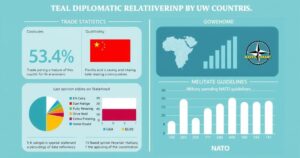Trump’s Tariff Plans: What to Expect and the Possible Impact
With Donald Trump’s anticipated return to the White House, tariffs appear set to become a pivotal issue once more. His plan to impose hefty tariffs, including a proposed 25% on Canadian and Mexican goods while raising duties on Chinese imports, reflects his ongoing focus on economic nationalism. Despite his claims that such measures would not only safeguard American jobs but also ease the federal deficit, the reality is much more complex. Here’s a closer look at how his tariff strategy could pan out and the potential impact on Americans.
Trump’s Tariff Strategy: An Overview of Proposed Rates
Trump’s return to the White House may reignite his previously aggressive approach to tariffs, a topic that remains a source of contention. The former president’s campaign promises to impose significant tariffs—25% on goods from Mexico and Canada and a 10% increase on all Chinese imports—paint a picture of a fortifying wall around American commerce, all in the name of curbing illegal immigration and drug trafficking. Such tariffs function as both a weapon against foreign competitors and a supposed balm for domestic industry, but, as history suggests, they are not without complications and controversy.
The Claims and Criticism Surrounding Tariffs
The former president, ever passionate about tariffs, once described them as “the most beautiful word in the dictionary.” According to him, they serve a multi-faceted purpose: to penalize unfair trade practices from external nations, deter American companies from relocating abroad, and generate significant revenue aimed at chipping away at the federal deficit. However, these lofty claims are often met with criticism about the potential repercussions tariffs could have on US consumers and businesses, particularly when prices inevitably rise as a result. During debates, Vice President Kamala Harris controversially dubbed Trump’s tariffs the “Trump Tax” to emphasize the burden they might place on everyday families.
Economic Reality: Who Truly Bears the Cost?
Interestingly, a noteworthy misrepresentation persists in Trump’s rhetoric: the notion that foreign nations pay the tariffs. In fact, it’s American companies—those who import goods—who bear the costs. Studies from credible institutions, including the US International Trade Commission, reveal that American consumers are the ones feeling the full financial impact of these tariffs. In one interview, Trump himself acknowledged uncertainty about increased prices for consumers, admitting he “can’t guarantee” that tariffs wouldn’t lead to such results. It’s a stark contrast to his assertion during his previous presidency, which he claimed cost Americans nothing—something CNN found to be unsubstantiated.
Implementation of Tariffs and Its Long-Term Effects
During his past term, Trump enacted tariffs affecting approximately 14% of US imports, though his campaign promised a sweeping application over 100%. Industry experts like Howard Lutnick, the Trump appointee for Commerce Secretary, noted that while tariffs can be a strategic tool, they must be employed judiciously, particularly on items that have no cheap alternatives produced domestically. Some products that bore the brunt of these tariffs included everyday items like TVs and bicycles, a burden that the current Biden administration has largely maintained, with some increases in tariff rates.
Future Implications and Financial Feasibility
Looking ahead, Trump has expressed ambitions that extend beyond merely offsetting costs with tariffs. He plans to create jobs with these measures and has proposed extending past tax cuts while eliminating certain taxes like those on tips and overtime, all while still claiming he could cut the national deficit. In a speech, he even suggested this tariff revenue might fund initiatives like childcare. However, experts warn that the reality of generating enough revenue through tariffs to back these grand plans is shaky at best; analysts project that such success might add an estimated $7.75 trillion to the national debt over the next decade, raising eyebrows on the viability of his proposals.
What is the goal of Trump’s tariff policy?
Trump’s tariffs aim to penalize foreign companies to protect US industries, but they could also lead to higher prices for consumers.
Do tariffs always benefit US businesses?
Though tariffs are designed to discourage imports, they can lead to increased prices for consumers.
How will tariffs affect average American families?
Some studies suggest families could face annual costs due to these tariffs, between $1,350 and $3,900 more on average.
Are Trump’s claims about who pays tariffs accurate?
Yes, Trump’s statements have often reported that foreign entities pay the tariffs, though economists argue otherwise; it’s mostly American consumers who carry that cost.
Will tariff revenue cover Trump’s proposed initiatives?
The feasibility of using tariff revenue to cover cuts or new initiatives is debated; many estimates suggest that the revenue wouldn’t suffice.
What percentage of imports were subject to tariffs during Trump’s presidency?
During his presidency, tariffs were applied to around 14% of US imports, affecting a variety of consumer products.




